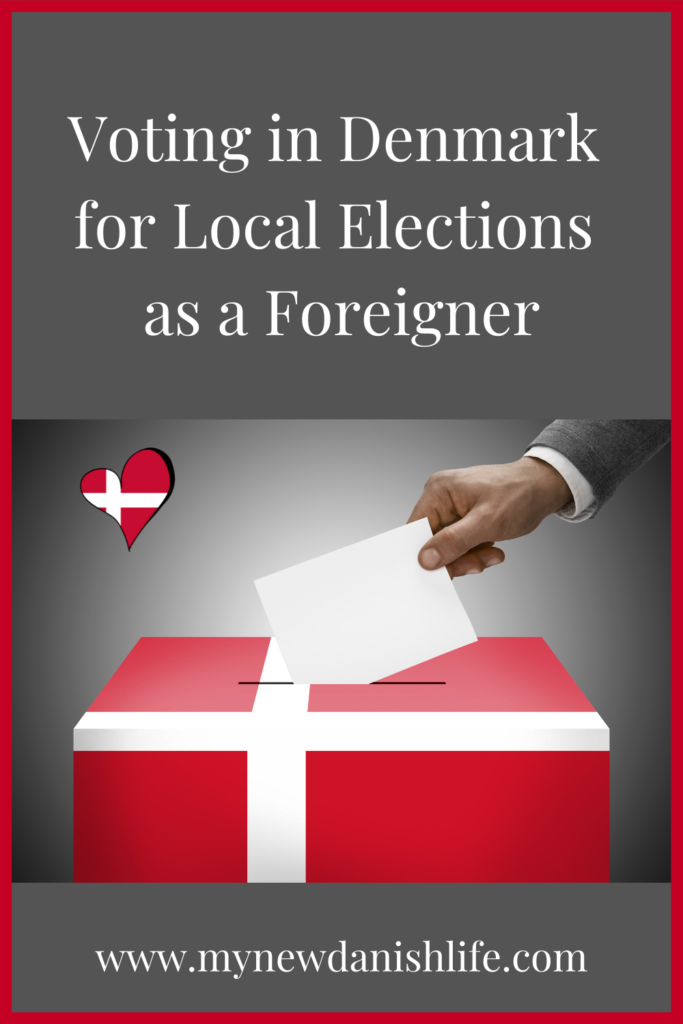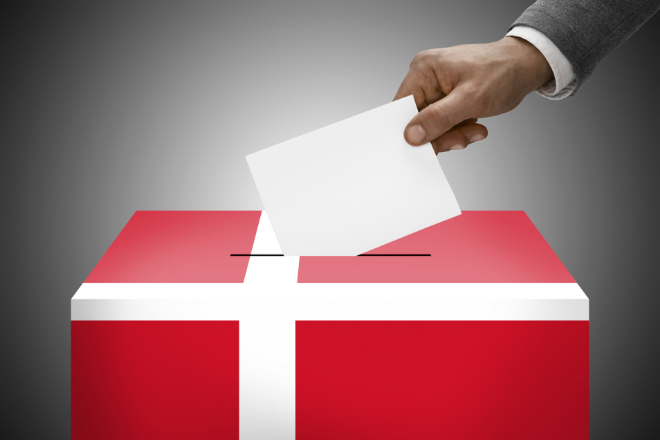
Voting in Denmark as a Foreigner
When I moved to Denmark, I never thought that voting in Denmark as a foreigner was allowed. I knew that after 9 years living in the USA, my husband couldn’t vote. It just seemed normal that foreigners wouldn’t have a say in politics, since that is what I was used to.
To be honest, I never paid much attention to the local elections in Denmark because I couldn’t vote here. It was interesting to see the votes being tallied on TV after all the ballots were in, but I never studied the different parties. It was all very confusing, but I thought it didn’t matter since I couldn’t vote anyway.
However, when I got my voter’s card in the mail after living in Denmark for 5 years, I was shocked. I had no idea that I would be able to vote in Denmark.
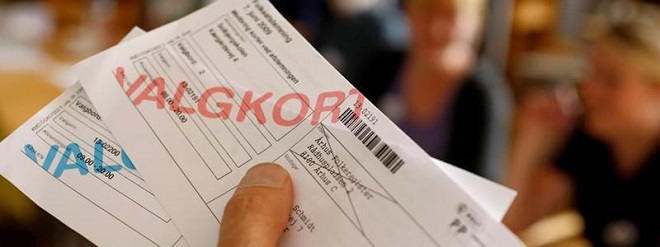
Now, I would like to share what I know about the voting process for foreigners, to help others become more prepared for their first time voting in Denmark! Here are all the details I learned before I voted.
This post may contain affiliate links, which means at no extra cost to you, I will make a commission if you click on a link and make a purchase. Thanks for supporting My New Danish Life!
Table of Contents
Who is eligible to vote in Denmark for local elections?
The way I found out that I was eligible to vote in Denmark was receiving my voter’s card in the mail. This came at the same time my Danish husband received his voter’s card. We were both surprised and a little unsure that it was true. I went online to do a bit of research as to which people are eligible to vote in Denmark, and this is what I discovered.
Though they are not allowed to vote in national elections, foreigners are allowed to vote in local elections. There are some requirements that you need to fulfill, though. Here are the details for voting for local elections, no matter who you.
Requirements to vote in Local Elections in Denmark
- The voting age in Denmark is 18 years old.
- You need to be a resident of Denmark. This doesn’t not mean you need citizenship. You just need to have a Danish yellow card. When I got my voter’s card, I only had temporary residency. Apparently, that was good enough.
- You need to be either a Danish citizen or a:
- citizen of another EU country
- Icelandic or Norwegian citizen
- a citizen of a non-EU country but have had residency in Denmark for at least 4 years.
This is how I was able to vote after 5 years. My 4th year of living in Denmark wasn’t an election year, so I had to wait until the next local elections to be able to vote. For me, that was after 5 years.
Because I was registered in the Danish system when I got my yellow card, I became automatically registered as a voter in my municipality (commune). This is how I was able to get my voter card without even knowing I was eligible. However, if you feel that you meet all of these requirements and didn’t get a voter’s card the week before voting, contact your municipality (commune) to check on it.
When and Where can you vote in Denmark for local elections?
Voting for local elections in Denmark happens every 4 years on the third Tuesday of November. For me, my first time voting was in 2021. You can count every four years from 2021 to get an idea of when the local elections will occur.
On your voter’s card, you will find the location of your voting place. Your voting location will always be in the municipality where you live and most often in the same town. The buildings in which you do your voting are usually bigger like school gymnasiums or sports halls. The polls are open from 8am to 8pm, so you will need to make sure that you plan your day wisely to get to vote between these times.

Are you looking to buy a car in Denmark? Check out this post to get more information on how to do that!
What are the different pollical parties in Denmark?
I’m not going to lie. Denmark doesn’t mess around when it comes to political parties. In fact, there are 12 main parties in Denmark. I have heard that there are some other, smaller parties, but I don’t know anything about them! However, there are some parties that are not too excited about outsiders to Denmark and aren’t in support of those voting in Denmark as a foreigner. That is why it is in every foreigners best interest to do research before voting.
Here is a list of the top 12 political parties in Denmark with links to their official websites, so you can read more about them.
- The Social Democratic Party (Socialdemokratiet) (A or S)
- The Liberal Party (Venstre) (V)
- The Danish People’s Party (Dansk Folkeparti) (DF or O)
- The Socialist People’s Party (Socialistisk Folkeparti) (SF)
- The Social Liberal Party (Radikale Venstre) (B)
- The Red-Green Alliance (Enhedslisten) (Ø)
- The Conservative Party (Det Konservative Folkeparti) (C)
- The New Right (Nye Borgerlige) (D)
- The Liberal Alliance (Liberal Alliance) (LA or I)
- The Liberal/Independent Greens (Frie Grønne) (Q)
- The Alternative (Alternativet) (Å or ALT)
- The Christian Democrats (Kristendemokraterne) (K or KD)
Are you a foreigner needing to take the A1 Danish Exam? Check out this post for details that can help you prepare!
What am I voting for in Local Elections in Denmark?
You will cast your vote for two positions for a local election in Denmark. These are for your local municipality (Kommune) and for your region. My region is West/Central Jutland (Vest-og Midtjylland). For the local municipality election, you are voting for the person who will take the highest seat in your municipality. This person is in charge of things that affect your “kommune”, like schools, daycares, roads, urban development, cultural events and nursing homes.
For the regional election, you will vote for the head of the regional council of your area of Denmark. This is a large area that includes many different municipalities. The head of the regional council makes decisions about healthcare and hospitals, regional transportation, and some environmental issues.
For each election, there will be a different piece of paper. You are only allow to vote for one person on each paper.
Online Tests to Help you Decide Which Candidate to Choose in Denmark
If you have read about all of the different political parties, you may feel that it is still hard to decide which party to support. You could research every person who is running, since this list is made public about 6 weeks before the election. However, the list of people running is LONG. At one point in time, the paper reminded me of something out of Harry Potter, because it resembled more of a long piece of parchment. I don’t think I had ever seen such long paper like that before in an election. Not in an American election…that is.

Kandidattests online in Denmark
Don’t let all the information sway you away from voting in Denmark as a foreigner. To help with this confusion, you can decide to take an online candidate test (Kandidattest). Dr.dk and tv2.dk have kandidattests that you can take. You will first need to select your “kommune” (municipality) and then just answer the questions. At the end of the “test”, you will be given a list of candidates that match your test results.
The test at dr.dk will give you suggestions for both elections. You can also see in which areas you agreed with the candidate and which you didn’t. This might help you decide what is really important to you as a voter.

Things to consider with Online Kandidtattests
These tests aren’t 100% accurate. I know some Danes who have said that they received results that were against what they thought would happen. I see these tests as a place to start. It can be overwhelming your first time to make the right decision. For me, I didn’t have that much time between realizing I could vote and actually having to vote. These tests helped me narrow down the parties, and then, I spent time reading more about a few parties instead of all of them. I will be more prepared for next time, since I have 4 years to prepare!
What happens on Election Day in Denmark at the Polls?
When it is the official day for local elections in Denmark, here is what to expect. Again, you need to go to the polling place that is stated on your voter’s card. Make sure you are there between 8am and 8pm. Most polling places will just require that you take your voter’s card with you.
If for some reason, you have forgotten or lost your voter’s card, you should still be able to vote with a valid ID like a passport or driver’s license. There may be different lines at the voting place that have different numbers on them. Your voter’s card may also tell you which of these lines to stand in.
Are you a parent wondering where to send your child to school in Denmark? Read this post about both Danish and International options.
The Voting Official at the Polling Place in Denmark
Once you have reached the person at the test, you will need to give them your voter’s card and tell them your birthday. Some places may also require you to mention your address, but it won’t be any questions you can’t answer. Someone else at this desk with give you two, long pieces of paper. For me, one was yellow, and one was white. This is how they separate them from the regional and local elections. You are only allowed to put ONE X on each paper.
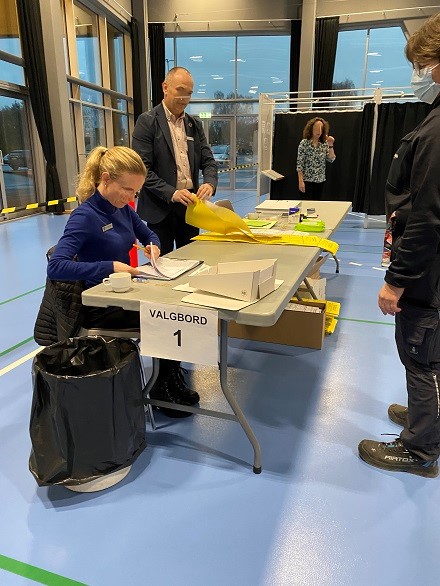
What happens in the Voting Booth in Denmark
After you get your papers, you will go into a voting booth. You need to enter this booth alone. There will be a pen in there for you to mark your ballot, as well as instructions on the wall. Hopefully, you can understand some Danish, since everything will be in Danish! LOL 😊 If not, that is why it is best to prepare yourself (with this blog post and researching candidates) before you get to the voting booth. Make sure you mark your ballot the way they show you on the sign in the voting booth. Otherwise, your vote won’t get counted! You’ll be fine!
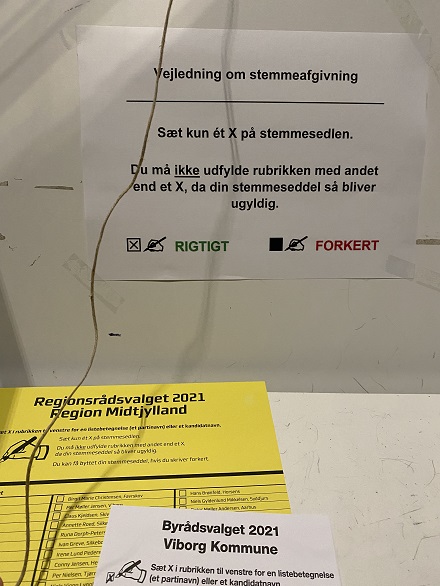
After you have made your choices, you will want to fold each paper in half. On the other side of the voting booth, there will be a person waiting in front of two large containers. They will show you where to place each ballot. That’s it. Done! 😊
Advanced or Early Voting in Denmark
For those of you needing to do advanced voting, you will need to contact the Citizen Center (Borgerservice). This is most likely going to be at your local town hall. Also, this can be done starting six weeks before the election up to the Friday before the election.
Are you new to Denmark and want to know the Important Dates for School and Work? Check out this post that explains it all in detail.
Overall thoughts about voting in Denmark as a foreigner
I have to say that I feel extremely fortunate to be voting in Denmark as a foreigner. Though I am not a citizen, I have a job, a house, and a family here. Denmark is my home. For starters, I pay taxes and am a member of the parent committee at my kids’ school. I am a part of Danish society, and I feel that I should be able to vote for what happens in my local area.
I do agree that voting for the national elections should be for the Danes. After all, that would give me a reason to become a citizen! 😊
I know that foreigners in other countries don’t have the right to vote for anything, no matter how long they live there. That is why I am not going to take this privilege for granted. Because so many other foreigners don’t have a voice, I want to make sure that I use my voice when I have the chance to do so.
Also, if you have questions about the Danish Parliament in general, you can visit their English site and learn more.
What are your thoughts?
I would love to know your thought about voting in your country for citizens as well as for foreigners.
You can also see the video that goes to this post on my YouTube channel: Coming in December 2021.
Pin it, Save it and SHARE it!
Subscribe and Join the Fun!


